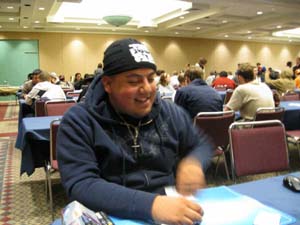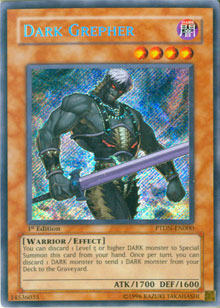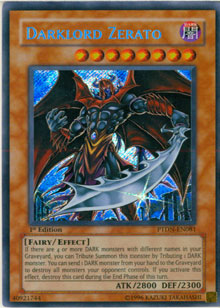 Once again I’m stuck in the time machine while writing this article: I’m writing this before Shonen Jump Championship Nashville, but
Once again I’m stuck in the time machine while writing this article: I’m writing this before Shonen Jump Championship Nashville, but
you’ll be reading it afterward. Unfortunately, I will be preparing for a Dark Armed Dragon-dominated metagame and this article is going to reflect what the metagame looks like today. By the time you read this, Light of Destruction will be premier-legal and the metagame will be quite different.
However I am going to try to patch the transition with a deck that should be considered for the next format. Light of Destruction offers up a lot of new decks that are quite similar to Dark Armed Return. That is to say, the idea is to clear the field entirely and push for massive damage in order to secure the win. The Lightsworn’s Judgment Dragon and the Batteryman group’s Short Circuit are two of the most powerful cards the Yu-Gi-Oh! TCG has ever seen, and alongside Dark Armed Dragon and Darklord Zerato they are going to be the difference-makers of the format.
Knowing how the premier level metagame is taking shape, you would be a fool not to prepare accordingly. Players are winning games in a matter of a few turns by going through great chunks of their decks. Like T-Hero before it, Dark Armed decks are disastrous if you don’t have disruption. Of course you want to both wield disruption properly and harness the power of the Dark cards yourself to make it far into your tournament. Mario Matheu proved that at Minneapolis when he made it all the way to the finals with a Light and Darkness Dragon build. This is the Dark Armed Return variant that made it the furthest in the last Shonen Jump:
This is as close to a control deck as Dark Armed Return got before the mid-format changes. Mario’s deck was still able to explode in similar fashion to more OTK-oriented decks, but the game plan was to use Light and Darkness Dragon to force the opponent to use multiple cards to take care of it. From that point the opponent would hopefully be unable to complete any sort of OTK and would have too few cards to defend from Mario’s moves.
Destiny Hero - Malicious and Destiny Hero - Dasher make two copies each because of their special summoning abilities. Both monsters will often help set up a tribute for Light and Darkness Dragon. Each can be discarded to Dark Grepher’s special summon effect as well,  allowing for further access to special summons. In fact Mario played two copies of Dark Grepher for that exact reason. Along with being able to fill the graveyard with three Dark monsters in one turn, Grepher provides tribute fodder for any of Mario’s tributes. Combining Grepher and Malicious together provides two free monsters without using your normal summon. Light and Darkness Dragon can be brought out as easily as drawing those three cards together.
allowing for further access to special summons. In fact Mario played two copies of Dark Grepher for that exact reason. Along with being able to fill the graveyard with three Dark monsters in one turn, Grepher provides tribute fodder for any of Mario’s tributes. Combining Grepher and Malicious together provides two free monsters without using your normal summon. Light and Darkness Dragon can be brought out as easily as drawing those three cards together.
The idea is that once Light and Darkness Dragon has been summoned winning the game should be within reach. Without spell speed 1 effects, most opponents can’t build up enough muscle to destroy you in one turn. Therefore they are going to have to waste multiple cards just to take out the Dragon. Since you know you can’t lose, there’s no need to invest anything on the field: from there you can arrange your plays so that the Dragon won’t destroy anything useful of yours, and will be replaced by an even more useful monster like Destiny Hero - Disk Commander or Darklord Zerato, when it finally goes down.
To complement the Dragon, Mario played the trio of trap pre-negators. Mind Crush, Trap Dustshoot, and Crush Card Virus can all prevent your opponent from winning, or can show you the path to victory by revealing your opponent’s hand. Three cards have never made so much of a difference in games before and Mario took advantage of it. One of the few good counters to Light and Darkness Dragon is Dark Armed Dragon. With an essentially free effect, the Armed Dragon can drop Light and Darkness Dragon’s ATK 500 points for each Dark monster in the graveyard. After just one use of its effect, it can even run over Light and Darkness Dragon in battle. The pre-negators all do an excellent job of dealing with Dark Armed Dragon by preventing it from being special summoned.
D.D. Crow is another card included primarily to counter Dark Armed Dragon. Removing Dark monsters from the graveyard slows the opponent down and puts him or her a turn or two off of dropping Dark Armed Dragon. With Light and Darkness Dragon out, this is all the  time you need to win the game. The Crow can also be used even with Light and Darkness Dragon on the field so long as it’s chained after the Dragon’s negation effect. When the opponent flags an Armed Dragon by wasting things like Dark Grepher or Destiny Draw when your Light and Darkness Dragon is on the field, you can chain the Crow to prevent your opponent from dropping the Dragon after all. This means your opponent is going to have to waste even more cards to take out Light and Darkness . . . if he or she even can. Either way, you’re set up and ready to take control of the duel.
time you need to win the game. The Crow can also be used even with Light and Darkness Dragon on the field so long as it’s chained after the Dragon’s negation effect. When the opponent flags an Armed Dragon by wasting things like Dark Grepher or Destiny Draw when your Light and Darkness Dragon is on the field, you can chain the Crow to prevent your opponent from dropping the Dragon after all. This means your opponent is going to have to waste even more cards to take out Light and Darkness . . . if he or she even can. Either way, you’re set up and ready to take control of the duel.
Light and Darkness Dragon can also be used offensively. One previous problem with the Dragon was that there was no good monster to drop alongside it. You don’t want to negate your own effects and allow your opponent to destroy monsters for free, so cards like Sangan or Card Trooper don’t make good attacking buddies. However Dark Armed Dragon can drop down beside Light and Darkness Dragon to really put your opponent into a tough position. Imagine staring down Light and Darkness Dragon and two Dark Armeds. You’ve only got two turns to solve that problem before you’re out of life points.
Finally, Light and Darkness Dragon provides offensive negation power. Imagine a scenario where you drop Light and Darkness Dragon and then Dark Armed Dragon with Return from the Different Dimension face down. Simply by chaining the Return to the final Armed Dragon activation, you can safely special summon a field of monsters to attack with.
Enemy Controller is another card that’s included for its versatility in both raw offense and more subtle disruption. Controller can make lots of offensive combos happen (especially with Dark Magician of Chaos), and it’s a great defensive card when you need to deal with an  opposing Dark Armed Dragon or Darklord Zerato. Taking your opponent’s monster with Enemy Controller is usually just as effective as flipping Threatening Roar. Controller can also give Mario a way to take care of opposing monsters by taking them and tributing them off.
opposing Dark Armed Dragon or Darklord Zerato. Taking your opponent’s monster with Enemy Controller is usually just as effective as flipping Threatening Roar. Controller can also give Mario a way to take care of opposing monsters by taking them and tributing them off.
The only new card in Mario’s build is D.D.R. - Different Dimension Reincarnation. D.D.R. is a bit more costly than Premature Burial or Monster Reborn, but can special summon cards from the removed-from-play pile instead of the graveyard. Considering that this is where Dark Magician of Chaos ends up every time he leaves the field, D.D.R. will most often be used to bring back the Magician of Chaos for another go. The free spell card Magician gets you essentially replaces the activation cost of Different Dimension Reincarnation, turning it and a card from your hand into Dark Magician of Chaos and a spell card from your graveyard. Not a bad trade.
Mario’s deck is all about control and versatility. You have to be able to deal with everything your opponent can throw at you and disrupt the opponent enough that he or she can’t win. His strategy was rewarded with a 2nd place finish at Minneapolis, and variants of his deck are sure to do well again in Nashville.
—Matt Peddle